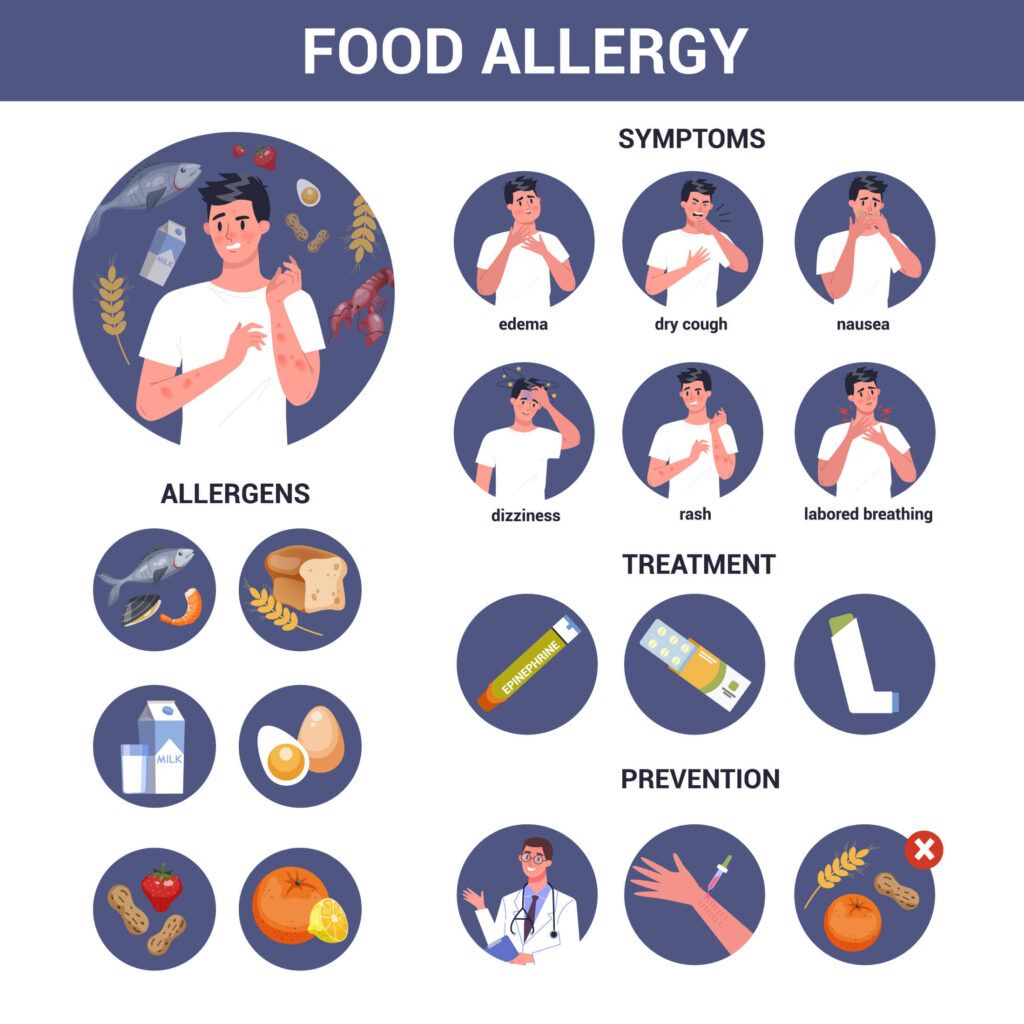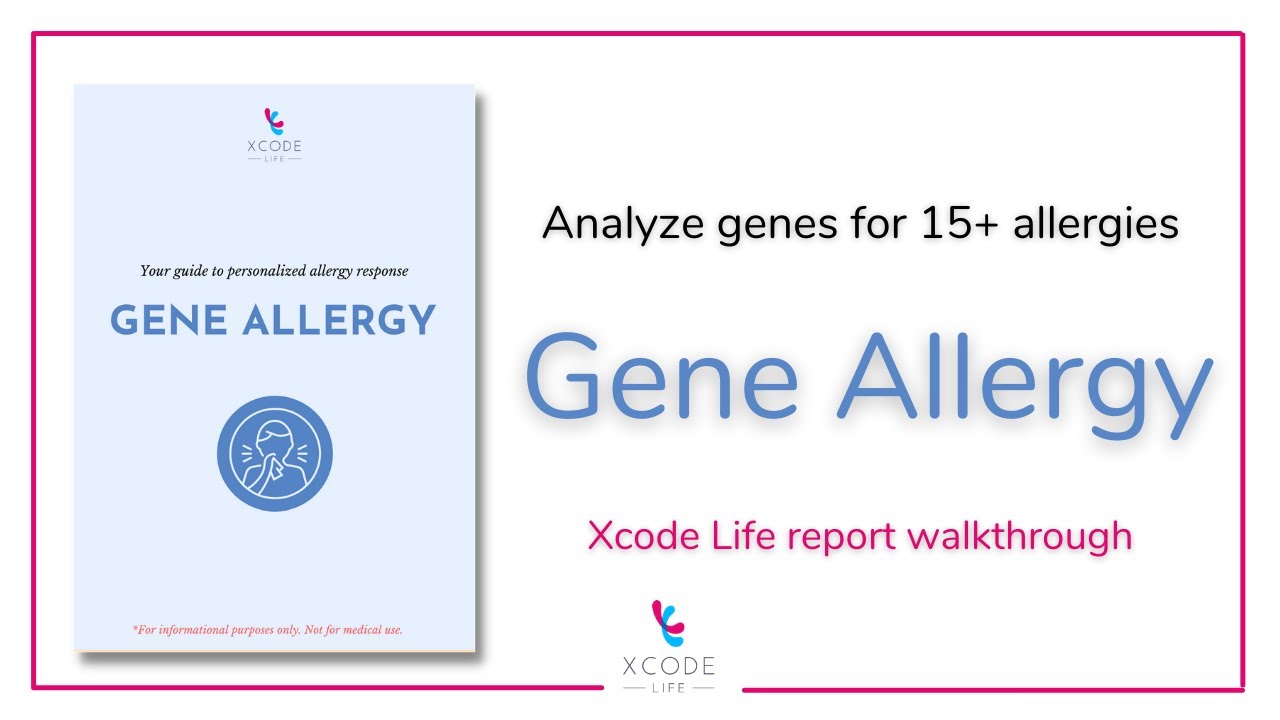Genetics of Food Allergies
Food Allergies - Brief Overview
Food allergies are abnormal immune responses to certain foods.
In food allergies, upon consuming the trigger food, the immune system mistakenly identifies it as harmful and starts attacking it.
It tries to protect the body against it by releasing histamine and other chemicals.
This can cause a range of symptoms, including
- Itching
- Hives
- Swelling
- stomach cramps
- Diarrhea
- In severe cases, difficulty breathing, loss of consciousness, and even death.
Some common foods that can cause allergies include milk, eggs, peanuts, tree nuts, fish, shellfish, soy, and wheat. Food allergies can develop at any age and can be lifelong.
Are Food Allergies Genetic?
Is food allergy a genetic condition?
The role of genetics in food allergies is complex and not fully understood.
However, research has shown that there is a genetic component to food allergies.
A family history of allergies, such as hay fever or eczema, is a strong risk factor for developing a food allergy.
Studies have also shown an increased risk in children with a parent/sibling with a food allergy.
Several genetic factors have been identified that may increase the risk of developing a food allergy.
For example, variations in certain genes involved in the immune system, such as the HLA gene complex, have been associated with food allergies.
Other genes, such as the FcεRI gene, involved in histamine release regulation, have also been linked to food allergies.
Research has also identified specific genetic changes that may increase the risk of developing a food allergy to certain foods.
For example, a change in the DLX2 gene, denoted as rs115218289, has been associated with an increased risk of peanut allergy.
Another example is gluten intolerance.
2 specific types of HLA-DQ gene, HLA-DQ2, and HLA-DQ8, are associated with increased risk for this condition.
Can Genetic Testing Help Understand Your Food Allergies Better?
Many types of genetic testing can be used to identify individuals who are at a higher risk of developing a food allergy.
This can be done by analyzing specific genes associated with food allergies, such as those involved in the immune response.
Genetic testing can also identify individuals with a specific genetic variant that increases food allergy risk.
The results help identify a food allergy before an individual exhibits symptoms.
The information provided by genetic testing can be used to help individuals and their doctors make informed decisions about their diet.
For example, say an individual is found to have a genetic variant that increases the risk of peanut allergy.
Then they may avoid peanuts or other related foods, such as tree nuts until further testing can be done.
Disclaimer
It's important to note that genetic testing is not a diagnostic test for food allergies.
A positive result from a genetic test does not mean that the individual definitely has a food allergy.
It only indicates that they may be at a higher risk.
Only a food allergy test can confirm if an individual has a food allergy.
Additionally, genetic testing is not a definitive way of predicting who will develop a food allergy.
Environmental factors also play a crucial role in the development of food allergies.
Overall, genetic testing can be useful for identifying individuals at a higher risk of developing a food allergy.
However, it should be used with other diagnostic tools and not as a definitive diagnosis.
Environmental Factors and Food Allergies
Several environmental factors may contribute to the development of food allergies. These include:
- Early exposure to allergens: Research suggests that early exposure to certain allergens, such as peanuts, may reduce the risk of a food allergy. On the other hand, delayed exposure to certain foods may increase the risk of developing a food allergy.
- Diet and gut bacteria: The composition of gut bacteria plays an important role in developing food allergies. Studies have shown that a lack of diversity in the gut microbiome can increase the risk of developing a food allergy. A diet high in processed foods and low in fiber can contribute to low gut microbiome diversity.
- Allergic sensitization: Allergic sensitization refers to the process by which the immune system becomes sensitized to an allergen. Studies have shown that exposure to environmental allergens, such as pollen, may increase food allergy risk.
- Air pollution: Studies have shown that exposure to air pollution can increase the risk of developing a food allergy.
- Maternal exposure to smoking and stress during pregnancy: Research suggests that smoking and stress during pregnancy can increase food allergy risk in children.
- Social and economic status: Children from lower socio-economic backgrounds are at a higher risk of developing a food allergy.

Diagnosis and Treatment of Food Allergies
Diagnosis and treatment of food allergies can be a complex process.
The following are some standard methods used to diagnose and treat food allergies:
- Skin prick test: A skin prick test is a quick and simple test that can identify specific food allergies. A small amount of the suspected allergen is placed on the skin, and the skin is then pricked with a needle. A raised, red, itchy bump at the test site indicates a positive result.
- Blood test: It can measure the levels of specific antibodies in the blood that indicate an allergic reaction to a particular food.
- Oral food challenge: An oral food challenge is considered the gold standard for diagnosing food allergies. It involves giving the individual small amounts of food allergens in a controlled setting. Then, under the supervision of a doctor, the reactions are noted.
- Food elimination diet: This involves avoiding the suspected food for a while and reintroducing it to see if a reaction occurs.
Treatment of food allergies typically involves avoidance of the allergen. This means identifying the specific food causing the allergy and eliminating it from the diet.
- Immunotherapy: In some cases, immunotherapy can desensitize the individual to the allergen. This involves giving the individual small, gradually increasing doses of the allergen over a period.
- Medications: Medications, such as antihistamines and epinephrine, can be used to relieve symptoms of an allergic reaction.
- Emergency treatment: In the case of anaphylaxis, emergency treatment, including epinephrine and a trip to the emergency room, may be necessary.
It's important to note that food allergies can be life-threatening and should be taken seriously.
Summary: Are Food Allergies Genetic?
The role of genetics in food allergies is complex and not fully understood. However, research has shown that there is a genetic component to food allergies. A family history of allergies, such as hay fever or eczema, is a strong risk factor for developing a food allergy.
Several genetic factors have been identified that may increase the risk of developing a food allergy. Genetic testing can be used to identify individuals who are at a higher risk of developing a food allergy. However, it should be used with other diagnostic tools and not as a definitive diagnosis. Understanding the genetic factors contributing to food allergies can help develop new diagnostic tools and treatments.
References
- The Impact of Family History of Allergy on Risk of Food Allergy: A Population-Based Study of Infants - PMC
- Genome-wide association study and meta-analysis in multiple populations identifies new loci for peanut allergy and establishes C11orf30/EMSY as a genetic risk factor for food allergy
- Allergic disease and risk of stress in pregnant women: a PreventADALL study | European Respiratory Society






